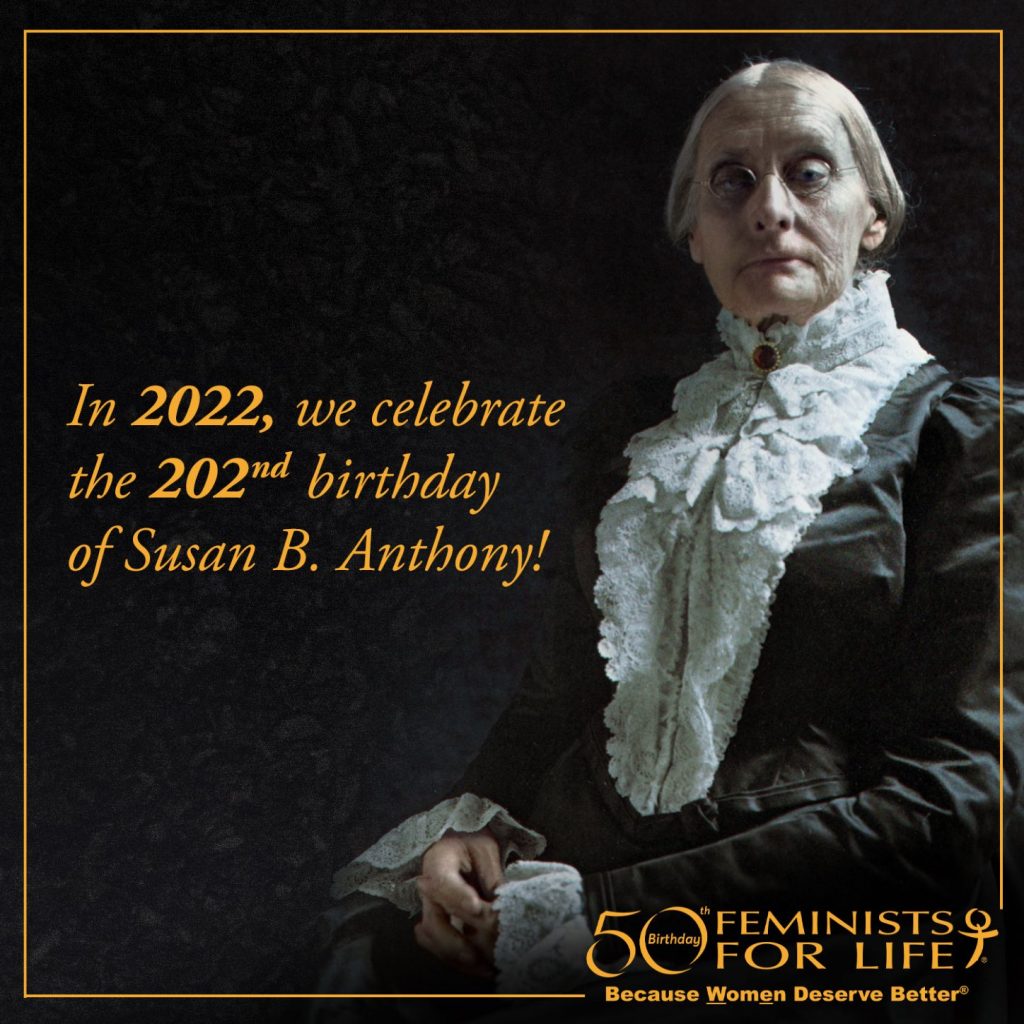
Susan B. Anthony was born on February 15, 1820, in Adams, Massachusetts, in what is now the Susan B. Anthony Birthplace Museum lovingly restored and owned by Carol Crossed.
After the family moved to Rochester, New York, they became active in the abolitionist movement, often welcoming Frederick Douglass and William Wilberforce. While Douglass became most famous in the U.S. for being a former slave, Wilberforce may best be remembered for standing with women who were silenced at the 1840 World Anti-Slavery Convention in London. If women were silenced, he would not speak.
Susan B. Anthony never made it to the Seneca Falls Convention. She was a teacher at a Quaker school, where she learned that men were making $10 a month, while women were making a paltry $2.10 a month.
Her parents and sister Mary went to a suffrage meeting, but it wasn’t until years later when she was introduced to the mother of the Women’s Movement, Elizabeth Cady Stanton, by Amelia Bloomer. (Bloomers, of course, were named after Amelia, who was the very symbol of dress reform!)
By this time, Anthony’s Quaker upbringing and her experience with the teachers union, temperance, and anti-slavery reforms prepared her perfectly to become the leader for in women’s suffrage. Soon after, Anthony heard Lucy Stone’s speech at the 1852 Syracuse Convention, and her passion as a campaigner for women’s rights began.
It started a year later when she advocated for women’s suffrage and married women’s property rights in New York State. In 1854, she wrote to Matilda Joslyn Gage that “I know slavery is the all-absorbing question of the day, still we must push forward this great central question, which underlies all others.”
Despite her priority, women’s suffrage, in 1856, according to the National Park Service in New York, “Anthony became an agent for the American Anti-Slavery Society, arranging meetings, making speeches, putting up posters, and distributing leaflets. She encountered hostile mobs, armed threats, and things thrown at her. She was hung in effigy, and in Syracuse her image was dragged through the streets.” All this for wanting to end slavery.
Stanton and Anthony founded the American Equal Rights Association and the radical newspaper, The Revolution. Both Black and White suffragists were members, most famously Stanton, Anthony, and Douglass. AERA’s constitution stated that they “worked to secure equal rights to all American citizens, especially the rights of suffrage, irrespective of race, color or sex.”
In 1868, Anthony became owner of the paper while she and Stanton were co-editors. Others would come and go over time. The masthead of the newspaper owned by Anthony proudly displayed their motto, “Men, their rights, and nothing more; women, their rights, and nothing less.” They would not advertise thinly disguised abortifacients, as Pillsbury Parker, a co-editor for a time, explained. Over a hundred mentions of abortion were all against abortion, no matter the author.
Susan B. Anthony never married. She was once complimented by a man who said that she “ought to have been a wife and mother.” Anthony replied,
“Sweeter even than to have had the joy of caring for children of my own has it been to me to help bring about a better state of things for mothers generally, so their unborn little ones could not be willed away from them.”
Other suffrage publications and groups emerged, all against abortion and looking for the root cause and solutions to the problems women faced.
By 1869, Stanton, Anthony, and others formed the National Woman Suffrage Association and focused their efforts on a federal women’s suffrage amendment.
Anthony and her three sisters voted in the 1872 presidential election, along with other suffragists across the country. Most women were stopped from illegally voting, but the young man that was there when Anthony voted was so shocked that her ballot was cast. Later, she was arrested in her home and put on trial in New York. The judge instructed the jury to find her guilty and without any deliberations; he imposed a $100 fine. Anthony refused to pay the fine and court costs, although she was allowed to speak on her own behalf to the all-White male jury. The judge did not sentence her to prison time, which meant she had no chance to appeal, and therefore the question of women’s suffrage had no chance to go before the Supreme Court of New York.
From 1881 to 1885, Anthony joined Elizabeth Cady Stanton and Matilda Joslyn Gage wrote the History of Woman Suffrage.
A lesser-known part of Anthony’s story was her support for universal suffrage. So when longtime friend and colleague Frederick Douglass determined that Black men should come first, she felt utterly betrayed. Race trumped sex: “I would rather cut off my right arm than lift two fingers to help Black men get the vote first.”
Many today take this quote out of context because they do not know of her work as an abolitionist. In March 1895, Ida B. Wells traveled to Rochester, New York, to speak about the need for anti-lynching laws at First Baptist Church. Despite being 75 years old, Anthony defended Wells when she was heckled. She welcomed Wells into her home for the remainder of her visit to Rochester.
Anthony also strongly objected when girls and Black children were not welcomed as White boys were to attend schools in New York.
Still, the suffragists were so committed to end slavery that they stopped their activism for women’s suffrage during the Civil War.
Most poignant, after passage of the 15th Amendment enfranchising Black men — often more so in theory than in practice — Anthony and Douglass reunited in their calls for women’s suffrage. At a suffrage meeting in Washington D.C., Douglass was invited by the White suffrage leadership to join them on the dais, and asked Anthony to escort him. That night, he was extremely excited as he told his wife about the day, and he suddenly fell unconscious. According to The New York Times, Anthony was visibly upset upon learning that her friend had passed.
Neither Anthony nor Stanton lived to see their most cherished dream, women’s suffrage nationwide, become reality. But it lived on with great leaders like Alice Paul, who finally achieved the 19th Amendment, named the Susan B. Anthony Amendment, in her honor.
Today, Anthony and Douglass remain close at Mount Rose Cemetery, both laid to rest in Rochester, New York, and together, they inspire us today.
Serrin M. Foster
President
Feminists for Life of America





